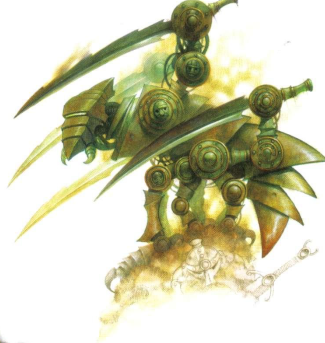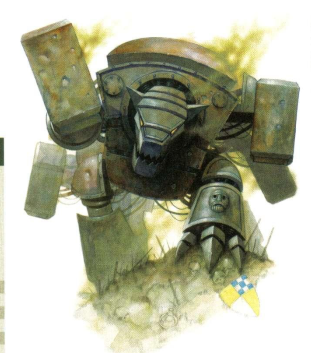Let's Read the 4e Monster Manual 2: Slaughterstone Construct
I think Slaughterstone Constructs first appeared on the D&D Miniatures game in late 3e. Their naming style marks them as a construct created after the “(Material) Golem” namespace had been mostly exhausted.
The Lore
The approach to an underground dwarf fortress usually consists of a number of narrow tunnels, and that’s where most of the fighting happens when these places are attacked. Tunnel fighting is a nasty affair, particularly when it’s two large armies going at it. No place to run, no place to hide. Each inch of ground is bought with lives, and when you advance you step on the bodies of foe and friend alike.
Slaughterstone Constructs are the dwarven answer to this problem. They’re defensive siege engines built for the singular purpose of making sure the only ones who die are the invaders. Their intended usage is that you set them loose on a tunel and watch them run through it while turning everyone inside into chunky salsa. Their extreme toughness and strength means not many armies can stand up to them even in a more open field.
Creating a proper slaughterstone construct is quite difficult. To sculpt the body, you need a solid block of stone upon which the blood of a hero has been shed. Even if you have that stone, only the very best dwarf artificers can turn it into a construct. You’ll only find these things defending the largest and wealthiest dwarven kingdoms, or other places that have good relationships with them.
Note that the blood requirement doesn’t mean you need to sacrifice a hero on the stone block. You could cut the stone from a cave or tunnel where that hero has fought. Alternatively, if your GM likes this sort of technically correct solution you could get yourself a brand new stone block and ask a certified war hero to prick their finger and let a drop of blood fall on it. Neither of these methods is easy (heroes don’t grow on trees!) but they’re far more ethical than sapient sacrifice.
If you have neither a master artisan nor a source of heroic blood but you still want your blender tank, you can pay a middling craftsdwarf for a knockoff that’s less reliable but still pretty strong.
The Numbers
We get three varieties of slaughterstone constructs here. Two “genuine” models and a knockoff. All of them are Large Natural Animates with the Construct keyword. They have darkvision, a ground speed of 6, and the ability to squeeze into Medium passages without any penalties and without granting combat advantage. They’re immune to poison, disease, and sleep.
Their Int is 1, the worst possible score, but you don’t need more than that when your only two functions are “walk forward” and “kill”. They probably respond to commands of equivalent complexity like “stop killing” and “go back to your garage”.
Slaughterstone Eviscerator

Eviscerators are armed with a large number of whirling scythe blades, and look a bit like super-edgy stone mantids. They’re Level 18 Brutes with 212 HP. The blades never stop moving, and to model that they have a Whirling Blades aura (2) that deals 10 damage to anyone caught inside.
As weapons, those blades are are Reach 2 and have the High Crit property. Their basic attack deals heavy damage to a single target, and they can also be used in a Whirling Bladestorm (recharge 6+) that hits everyone in a Close Burst 2 for average damage. This makes them as dangerous in the open as in a tunnel.
Slaughterstone Hammerer

These are more robust than eviscerators and mount stone hammers instead of blades. Once they reach you, it’s really hard to get away from them. Hammerers are Level 25 Soldiers with 233 HP.
They project a Thunder Step aura (2) that slows those caught inside. The hammers can be used in two different attacks: a basic Slam that deals average damage and knocks prone, and a Hammerstrike that deals the same damage and dazes (save ends).
None of the hammerer’s skills mark enemies, but if you use them properly enemies will have no option but to attack the hammerer anyway.
Slaughterstone Slicer
This is our “knockoff”, described as a less powerful version of a genuine eviscerator. It’s a Level 11 Elite Brute with 276 HP.
Slicers have pretty much the same attacks and traits as eviscerators, with smaller numbers due to the level difference. Their Bladestorm is supposed to be an encounter power that recharges when the slicer is first bloodied, despite the “at-will” tag on it.
They also have a tendency to malfunction, becoming dazed for a turn after they either deal or take a critical hit.
Sample Encounters and Final Impressions
Fourth Edition’s combat rules make these constructs even more dangerous than the lore indicates. Both the lore and the rules say a construct “plugs” a tunnel and prevents enemies from passing through. The rules also say that allies may freely move and attack through each others’ spaces.
This means slaughterstone constructs pair really well with artillery monsters, and with controllers that have good ranged attacks. They’re also pretty good with skirmishers who can dart forward, attack, and move behind the construct again. Even if they can’t do all that in the same turn, their exposure to the PCs is still reduced.
Our example encounters are:
-
Level 11: 1 duergar blasphemer, 2 duergar fleshtearers, 1 slaughterstone slicers. Looks like it’s not just dwarves who build these.
-
Level 18: 2 Eldritch Giants, 1 Nothic Mindblight, 2 Slaughterstone Eviscerators. Maybe they conquered a dwarf fortress and stole the constructs?
-
Level 25: 1 Beholder Eye of Chaos, 1 Oni Thunderer, 3 Slaughterstone Hammerers. This is the “strong artillery”, “mobile skirmisher” setup I mentioned, in its epic incarnation. You think you’re safe because the corridor is 6 squares wide, and then you see three constructs side by side blocking all of it.